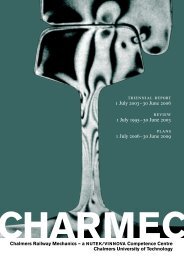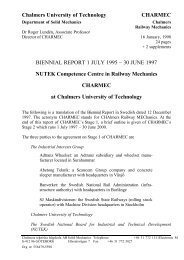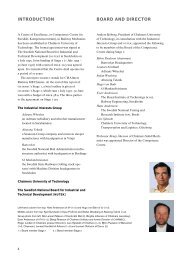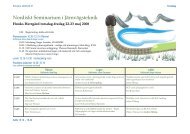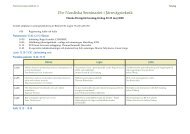Create successful ePaper yourself
Turn your PDF publications into a flip-book with our unique Google optimized e-Paper software.
Materials and maintenance – Material och underhåll (MU) – Werkstoff und Unterhalt – Matériaux et entretienMU8. BUTT-WELDING OF RAILSStumsvetsning av rälStumpfschweissen von SchienenSoudure bout à bout de railsProject leaderand supervisorAssistant supervisorProfessor Lennart Josefson,Applied MechanicsDr Jonas Ringsberg,Assistant Professor,Applied MechanicsDoctoral candidate Mr Anders Skyttebol(previously Anders Salomonsson),(from 2001-03-01;Lic Eng before start of project)Period 2000-01-01 – <strong>2003</strong>-06-30(– 2004-03-31)Chalmers budget Stage 2: ksek 450+100(excluding university Stage 3: ksek 1850basic resources) Stage 4: –Industrial interests Stage 2: –in-kind budget Stage 3: ksek 200+150(Banverket+Inexa Profil)Stage 4: –Two different methods are used to butt-weld rails inSweden: In stationary installations flash welding is appliedto produce longer units while in the track thermitewelding is used for the final joining. The welding processcan affect the mechanical properties of the rails in twoways. First, residual stresses from the welding interactwith stresses from the operational load on the track (globalfatigue load and local contact load). This influencessensitivity to initiation of rolling contact fatigue cracksand thus the need for maintenance of the rails. Second,deformations in the weld joint affect the straightnessof the rails and thus the running dynamics of the trains.The aim of the mu8 project is to quantify the impact ofthese two effects.Rendering of flash butt-welding and photo of measurement set-upat Sannahed in project MU8A detailed three-dimensional numerical simulation ofthe electrical, thermal and mechanical fields during flashwelding has been performed. Data for the thermal andelectrical analyses were obtained both from the manufacturerof welding equipment, esab, and from a visit toBanverket’s shop at Sannahed. Verifying experimentswith the welding process were carried out at this facilityin December 2001. The rail material used in the experimentswas supplied by Inexa Profil before it closed downin October 2001. The growth of fatigue cracks from defectsat the rail weld has been studied for a specific loadingcase on Malmbanan (the Iron Ore Line in northernSweden with axle load 30 tonnes and speed 50 km/h)where information on contact forces is available. Theredistribution of welding residual stresses and the growthof fatigue cracks from defects in the rail weld have beensimulated. The time period for growth of cracks from asize detectable by ultrasonics to a critical size has beendetermined. A numerical and experimental benchmarkfor the welding residual stress field is currently being runby a working group within iiw (International Institute ofWelding) and the quality of the present fe-model will bechecked in this test. The mu8 project has been delayedon account of Anders Skyttebol’s leaving for service asofficer in the reserves of the Swedish Army. A new proposedfinal date is 2004-03-01.Lennart Josefson, Anders Skyttebol and Jonas Ringsberg:Numerical simulation of welding operations in connectionto railway rails, Document IIW-X/XIII/XV-RSDP-75-02presented at IIW (International Institute of Welding) GeneralAssembly, Copenhagen (Denmark) June 2002, 2 ppAnders Skyttebol and Lennart Josefson: Numerical simulationof flash butt-welding of railway rails, Proceedings 7th InternationalSeminar on Numerical Analysis of Weldability, Graz-Seggau (Austria) September-October <strong>2003</strong>, 21 pp (to appear)PhD student Anders Skyttebol (left) and his supervisor ProfessorLennart Josefson in project MU8Anders Skyttebol, Lennart Josefson and Jonas Ringsberg:Fatigue crack growth in a welded rail under the influence ofresidual stresses, Engineering Fracture Mechanics (special issueon fracture mechanics of railway components, to appear)38



